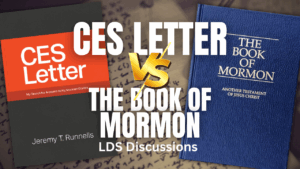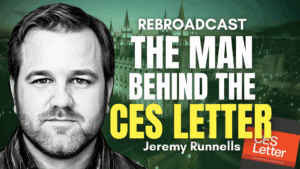“View of the Hebrews” is a book first published in 1823 by Ethan Smith of Vermont. In “View of the Hebrews,” Ethan Smith argues (among other things) that the Native Americans were descended from the Lost Ten Tribes of Israel. This book was so popular that it had a second printing in 1825.
Mormon General Authorities and apologists have feared “View of the Hebrews” for over a century, starting with B.H. Roberts in the early 1900s.
Why is “View of the Hebrews” potentially problematic for the Mormon church and the Book of Mormon? A few reasons:
- Joseph Smith claimed to have come up with the idea for the Book of Mormon the VERY SAME YEAR (1823) that “View of the Hebrews” was first published. Coincidence?
- Ethan Smith (the author of “View of the Hebrews”) was Oliver Cowdery’s pastor in Vermont PRIOR to his working with Joseph Smith as Book of Mormon “scribe,” and it is certain that Cowdery was familiar with the book. Coincidence?
- Mormon General Authority and historian B.H. Roberts wrote hundreds of pages doing research on the disturbing similarities between View of the Hebrews and the Book of Mormon. Later, B.H. Roberts went on to lose his testimony in the historicity of the Book of Mormon. Coincidence?
Recently, the brilliant Radio Free Mormon decided to read “View of the Hebrews” from cover to cover to see what the “hubub” is all about.
Join us as we explore the following questions:
- What is View of the Hebrews fundamentally about?
- What are the important similarities and differences between View of the Hebrews and the Book of Mormon?
- Was Ethan Smith’s “View of the Hebrews” a source of inspiration for the Book of Mormon?
- What cultural dynamics were at play in upstate New York in the early 1820s that could have influenced BOTH books?
- Are there any direct connections between “View of the Hebrews” and Joseph Smith?
- Why has “View of the Hebrews” caused so much concern for Mormon apologists, from B.H. Roberts to today? How have Mormon apologists responded to View of the Hebrews?
- Does “View of the Hebrews” present significant, compelling problems for LDS Church and Book of Mormon truth claims?




6 Responses
Plagiarism is not the question. The question is WHEN was the Book of Mormon written.
If someone found a copy of “View of the Hebrews” without its copyright page or other identifying material, historians would look at the major thesis and ideas presented and would be able to determine that it was written around the early 19th century.
Similarly, if someone found a copy of the Book of Mormon without its copyright page or other identifying material, historians would look at the major thesis and ideas presented and would be able to determine that it was written around the early 19th century.
The shared thesis (i.e., the forest) of a Biblical/Hebrew origin to the Native Americans is a fingerprint that dates both books as being an outdated and rejected theory that was common around the early 19th century, but widely and wholly rejected now.
It’s a red herring for apologists to argue that Joseph was too dumb and the Book of Mormon is too amazing because the early 19th century fingerprint remains.
I’m really glad to have this discussion about View of the Hebrews. I bought a copy and read it three years ago. It was obvious that the overall theme was a match to the theme of the Book of Mormon, but not that it was a direct copy-cat form of plagiarized work. For a wonderful example of plagiarism in the Book of Mormon, we can look at the Isaiah chapters. However, VOH and the BOM are comparable MEMES of the 19th century. They are both reflections of the conquerors inner conflict and rationalizations. Points of reference include the Indian Removal Act of 1830, the same year the BOM was published. Public policy was being implemented politically to remove the native americans just as Joseph was publishing his opinion piece on current events. And another one that I think is interesting is the Last of the Mohicans published in 1826. This novel doesn’t claim to be anything but fiction, but as you read it, it plays out the same inner conflicts of interests, european settlers both befriending and warring against the native americans. Not that it is about lost tribes, but only that it wrestles with the social dilemma of their day in its own fictional way. So when Tad Callister bemoans that Joseph couldn’t have possibly read this work or that work to copy, poor Joseph didn’t have the time! It is a straw man. Joseph didn’t have to read any particular one. The entire social environment was steeped in this idea that the native americans were a fallen people, “savages” that needed redemption (assimilation) or justification for extermination (punishment of God). A Lost Tribe Theory simply resolved the conflict quite nicely for a Christian worldview. It was every where in their environment, newspapers, books, sermons, and dinner table discussions. Joseph wasn’t innovating at all, he was parroting.
Quetzalcoatl is both a deity and a historical person. Ce Acatl Topitzin Quetzalcoatl was a political leader in the city/polis of Tollan. The scant information reveals that he was a warrior turned priest leader. The Deity is present in one form or another from the Late Preclassic onwards. The Pyramid of the Serpent in Teotihuacan is perhaps the signature monument. Teotihuacan [named by the Mexica as where “men became gods”] has been known, but not necessarily excavated since pre-colombian times. Alexander of Humboldt took notes from maps [currently misplaced unfortunately] on the National Archives. Humboldt was a mining expert and he and the crown had mutual interest in this subject. Humboldt learn thru these maps about Chaco Canyon and what we know here in the States as Aztec Ruins/Salmon Ruins and Mesa Verde. Humboldt wrote commentaries naming the origin of the people known here in the States as Aztecs as on these places and then trekking south as the Mexica had re-spun their mythical origin stories. Quetzalcoatl has been described as a “white” personage albeit the mesoamerican context is not necessarily a real flesh and blood person with white skin but a personage with a costume. The Hopi, for example, hold Pahana , the long Lost White Brother of the Fire Clan as the personage that will eventually bring the World into Balance, an important religion item in Hopi culture. Yet Hernan Cabeza de Vaca was NOT mistaken for Pahana. He and his companions were respected across their route as healers and even sorcerers but not as deities. As a convert the mission stated by the BoM , It’s dedication was a somewhat refreshing change in an otherwise colonial and demeaning view of many Americans on pretty much anybody else south of 3000 Deg Kelvin skin color. Need a bit more info if you’re going to include Arido-America, Meso American, Mississippian culture in your beating of the BoM. Albeit the conversion will “restore” Lamanites to a delightsome condition it is clear, reading between the lines of the BoM that said thing was never fully accomplished, not even culturally.
When I have heard the arguments in the past that ‘View of the Hebrews’ was a source of the BOM and that Oliver Cowdrey was very familiar with the book and Ethan Smith, I understood the argument being made was that Oliver Cowdrey was ‘in on it’. Based on my limited knowledge of Oliver Cowdrey, I found it unlikely that Smith and Cowdrey were in on it together. After listening to this podcast, however, I believe that Oliver Cowdrey and his ideas (and Ethan Smith indirectly) had a major impact on the story of the BOM. I suspect that Oliver Cowdrey was very excited and moved upon when he learned of the BOM because it fit within his narrative that he had constructed of the Native Americans, which was influenced by Ethan Smith’s teachings. I imagine that JS and Oliver spent a lot of time discussing their ideas/beliefs of the origins of the Native Americans. During this time, he was likely influencing JS’s ideas of the Native Americans and thus the story of the BOM and that is why it so closely resembles the overall story of the ‘View of the Hebrews’. JS wouldn’t have needed to read or even know about the ‘View of the Hebrews’ to have been influenced by it if Oliver was very familiar with it and was espousing it’s theories to JS.
*Jeopardy*
A: this book was authored by the religious man Smith in the early nineteenth century in New England describing the origins of the Native American people as being descendants arriving from Israel.
Q: Who is Ethan Smith?
It is seems very similar to the way we know that the Adam Smith bible commentary influenced the JST. Adam smith would conjecture something, or make a statement and Joseph smith would just stick the conjecture into the scripture. The same thing happens here it is conjectured that tribes may have moved from the north into the south, and the Book of Mormon codifies it into scripture it seems like an MO. Joseph smith liked to take theories and discussion points about doctrine, and just make scripture around them. I also do wonder if Joseph Smith just had an immediate liking of writers with the last name Smith.